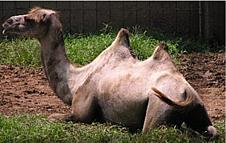Camel
A camel is either of the two species of large even-toed ungulate in the genus Camelus, the Dromedary (single hump) and the Bactrian Camel (double hump). Both are native to the dry and desert areas of Asia and northern Africa. more...
The term camel is also used more broadly, to describe any of the six camel-like creatures in the family Camelidae: the two true camels, and the four South American camelids: Llama, Alpaca, Guanaco and Vicuna. For an overview of the camel family, see Camelidae. For more information on the two true camels, see Dromedary and Bactrian Camel.
The name camel comes via the Greek kamelos from the Arabic jamal or the Hebrew gahmal, all meaning "camel".
Camels are well known for their humps. They do not store water in them as is commonly believed. Their humps are a reservoir of fatty tissue, while water is stored in their blood. This allows them to survive days on end without food and water.
Bactrian camels have two coats: the warm inner coat of down and a rough outer coat which is long and hairy. They shed their fiber in clumps consisting of both coats and is normally gathered. They produce about 5 pounds of fiber annually. The fiber structure is similar to cashmere. The down is usually 1-3 inches long. Camel down does not felt easily. The down is spun into yarn for knitting.
Humans first domesticated camels approximately 5,000 years ago. The Dromedary and the Bactrian Camel are both still used for milk, meat, and as beasts of burden—the Dromedary in northern Africa and western Asia; the Bactrian Camel further to the north and east in central Asia.
Distribution and numbers
Although there are almost 13 million Dromedaries alive today, the species is extinct in the wild: all but a handful are domesticated animals (mostly in Sudan, Somalia, India and nearby countries), as well as South Africa, Namibia and Botswana. There is, however, a substantial feral population estimated at 700,000 in central parts of Australia, descended from individuals that escaped from captivity in the late 19th century. This population is growing at approximately 11% per year and in recent times the state government of South Australia has decided to cull the animals using aerial marksmen, the reason being that the camels use too much of the limited resources needed by sheep farmers. For more information, see Australian feral camel.
The Bactrian Camel once had an enormous range, but is now reduced to an estimated 1.4 million animals, mostly domesticated. It is thought that there are about 1000 wild Bactrian Camels in the Gobi Desert, and small numbers in Iran, Afghanistan, Turkey and Russia.
A small population of introduced camels, Dromedaries and Bactrians, survived in the Southwest United States until the early 1900s. These animals, imported from Turkey, were part of the US Camel Corps experiment and used as draft animals in mines, and escaped or were released after the project fell through.
Read more at Wikipedia.org



